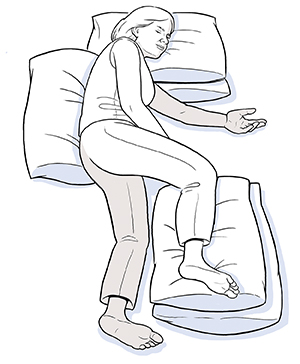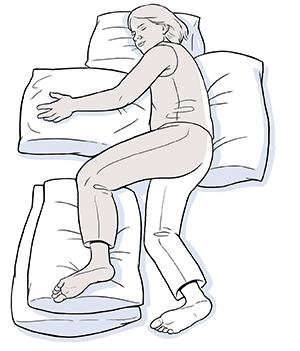Good Positioning After a Stroke
Many people who have a stroke have problems with the arm and leg on one side of their body. Hearing and seeing may also be reduced on that side. The eye muscles may work extra hard. Or they may become fixed from always looking in the direction where there is no vision problem. Good positioning after a stroke can help treat problems with your affected arm, leg, and vision. It can also help prevent new problems from developing.
What happens after a stroke
A stroke is when part of the brain suddenly doesn’t get oxygen. This can happen if a blood vessel to the brain gets blocked, or if there is bleeding in your brain. A stroke causes some of the cells in your brain to die. This can cause multiple problems.
Stroke often causes paralysis of one or more of the muscles of your arm and leg on one side of your body. This is called hemiplegia. Or you may have a less severe condition called hemiparesis. This is weakness on one side of your body. One or more of these muscles might feel tight instead of weak. In general, stroke might increase or decrease the normal muscle tone in these muscles. A stroke can also lead to numbness or less feeling on the affected side of the body.
This lack of feeling can lead to more problems, because it may make you less aware that a part of your body is out of alignment. This can lead to chronic shoulder pain or partial shoulder dislocation. If you are unable to move a part of your body, this can lead to pressure sores.
Why good positioning after a stroke is important
After a stroke, you may have less ability to move certain parts of your body on your own. This can lead to problems such as:
-
Pressure sores
-
Chest infections
-
Blood clots in the legs
-
Blood clots that travel to the lungs (pulmonary embolism)
-
Urinary tract infections
-
Constipation
-
Less range of motion in a joint
-
Permanent muscle shortening (contracture)
-
Partial separation of your shoulder joint
-
Muscle shrinkage
-
Blood pressure problems
-
Swelling
-
Chronic pain in an affected limb
-
Muscle spasticity
Getting in and out of bed as soon as possible after your stroke can reduce the chances of these problems. You may be at risk of some of these problems even if you are able to get out of bed for part of the day. A caregiver may need to help you change your position every few hours. Your positioning needs will depend on how severe your stroke was and which parts of your body were affected.
In all cases, good positioning helps you prevent more harm to your affected limbs. Good positioning also helps prevent future pain and helps you maintain the normal range of motion in your muscles.
Setting up your room
Position objects in your room so that your affected side gets as much activity as possible. Make the stroke-affected side of your body work harder. To do this:
-
Arrange the furniture in the room so you have to turn your head toward your injured side for eye contact.
-
Set up your bed so you get in and out of it with your affected arm and leg.
-
Place your table on your affected side for meals, so you have to look past your area of vision problems.
-
Place your TV so you have to turn your affected side when watching.
-
Tell visitors and medical caregivers to approach you from your affected side.
You may need help turning your head toward your affected side right after the stroke. In time, you will be able to do this on your own.
Good positioning when lying down
When you're lying down, the bed should be flat. Don’t tilt the head or foot of your bed. This position can worsen muscle tightness.
-
When lying on your affected side, use one or two pillows for your head. Your affected shoulder should be positioned comfortably. Place your unaffected leg forward on one or two pillows. Place more pillows in front and behind you. This is an important position, as it increases awareness of your affected side as you are lying on the bed. It also leaves your unaffected side available for tasks.

-
When lying on your unaffected side, use one or two pillows for your head. Your affected shoulder should be forward with your arm supported on another pillow. Place your affected leg backward on one or two more pillows. Place a pillow behind you. This position can let you practice doing tasks with your affected side, if possible.

-
When lying on your back, place three pillows supporting both your shoulders and your head. Place your affected arm on a fourth pillow. Keep your feet in a neutral position. You can also place another pillow beneath your affected hip. You don’t need to stay in this position if you find it uncomfortable.
Good positioning when sitting up
-
When sitting in a chair or wheelchair, sit well back into the center of the chair or wheelchair. Place your arms well forward onto two pillows on a table. Your feet should be flat on the floor. Keep your knees directly above your feet. The nursing staff will help you spend some time in this position as soon as possible after your stroke. Over time, you will be able to spend a longer period of time in this position. Get help right away if you start slipping down while you are sitting in a chair or wheelchair.
-
When sitting in bed, sit upright, supported by pillows. Place both arms on pillows. Keep your legs supported for comfort. Sitting in bed is usually only advised for limited periods, since it is hard to keep up proper posture in this position.
Aids to help with positioning
Your physical therapist may show you other positions that are safe and comfortable for you. You may need to use supports, like wedge pillows. You may also need slings or braces, to help keep your arm and leg in a safe position.
Watching your recovery
As you recover, your healthcare team will continue to assess what positions are best for you. As you regain more function, you may be able to make fewer changes to your positioning.